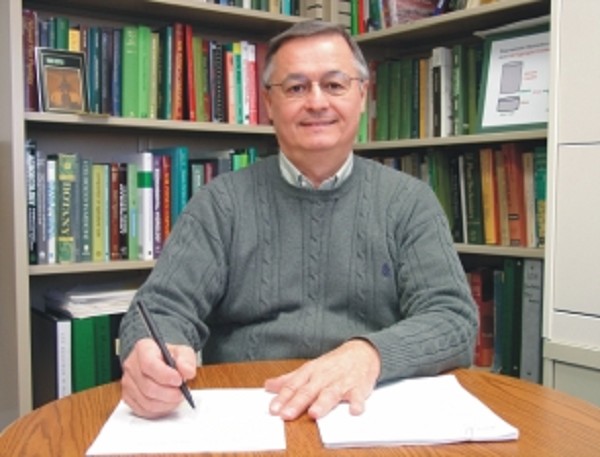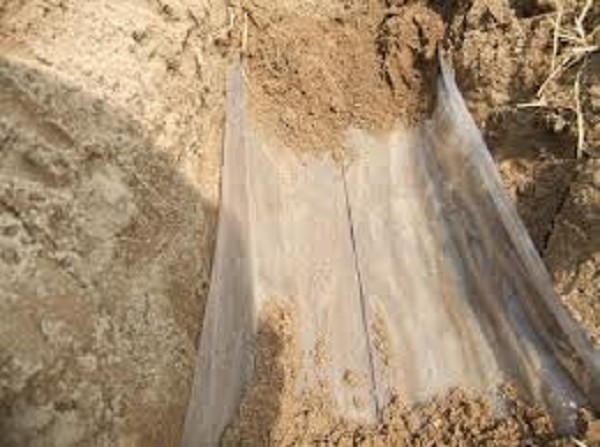DROUGHT SOLUTION? New MSU Process Saves Rainfall, Doubles Yield
May 19, 2013
Leave a Comment
|
||||||||||
| Printer Friendly Story View |

MSU Ag Guru -- Alvin Smucker.

Water retention membranes are made of flexible polyethylene.
The world is heating up, and climate change isn't going away. Researchers at Michigan State University have developed a water retention membrane to trap water molecules beneath the soil. The material works so well that while a colossal drought wilted a huge swath of U.S. produce last year, MSU's test crops actually increased production.
Defying nature?
Or enhancing it?
Will the arid lands of many Third World countries now become fertile, largely ending hunger?
Those questions arise from a new rainfall saving process developed by Michigan State University agricultural scientists.
MSU reports that during the worst drought in a half-century, last summer, MSU researchers nearly doubled corn production on test farms using water-saving flexible polyethylene membranes buried below plant root zones.
The subsurface water retention technology was developed by Alvin Smucker, MSU professor of soil biophysics and MSU AgBioResearch scientist. His invention uses contoured, engineered films, strategically placed at various depths below a plant's root zone to retain soil water. Proper spacing also permits internal drainage during excess rainfall and provides space for root growth.
"This technology has the potential to change lives and regional landscapes domestically and internationally where highly permeable (sandy) soils have prohibited the sustainable production of food," says Smucker, adding:
"Water retention membranes reduce quantities of supplemental irrigation, protect potable groundwater supplies, and enable more efficient use and control of fertilizers and pesticides."
"Coarse, sandy soils found in semi-arid and arid regions have large pores that absorb large quantities of rainfall," says Gizmag.com. "However, they retain less than 20 percent of the water in the root zone that sits between the surface and depths of 60 to 70 centimeters (24 to 27 inches), leaching losses of nutrients and other chemicals into ground water as the water drains away."
The polyethylene barriers are faster and less labor intensive to install than asphalt barriers, as well as being more durable, lasting at least 40 years.
The applicability of SWRT extends to a broad range of agricultural crops, as well as growing cellulosic biomass feedstock on marginal lands. In last summer's trials, on irrigated sands near Benton Harbor, SWRT-improved sands produced 145 percent more (640 cwt per acre) cucumbers than did the control fields (440 cwt per acre) without water saving membranes.
Smucker and his team dramatically increased corn grain production on SWRT-improved sands near East Lansing.
Last summer, irrigated corn grain yields increased 135 percent (213 vs. 158 bu/a for controls) on conventional 30-inch row spacings and 174 percent (268 vs. 154 bu/a for controls) on 15-inch row spacings.
Smucker and Kurt Thelen, professor in the plant, soil and microbial sciences department, together with MSU horticultural faculty Mathieu Ngouajio and Ron Goldy, are leading teams of scientists, engineers, and industrial agricultural experts in implementing the subsurface water retention membranes on farms in irrigated sandy regions of southwestern Michigan, and the semi-arid and arid regions of the southwestern and the mid-western United States.
Expanded MSU faculty teams including John Whims and Amirpouyan Nejadhashemi are also exploring opportunities to overcome hunger with SWRT water-saving membranes in several global locations.
Smucker's work in developing the prototype and conducting field testing was funded in part by the Michigan Initiative for Innovation and Entrepreneurship (MIIE).
| Printer Friendly Story View |
|
|

Dave Rogers |
|
|
|
Printer-Friendly Story View
0200 Nd: 04-16-2024 d 4 cpr 0
12/31/2020 P3v3-0200-Ad.cfm
SPONSORED LINKS
12/31/2020 drop ads P3v3-0200-Ad.cfm


